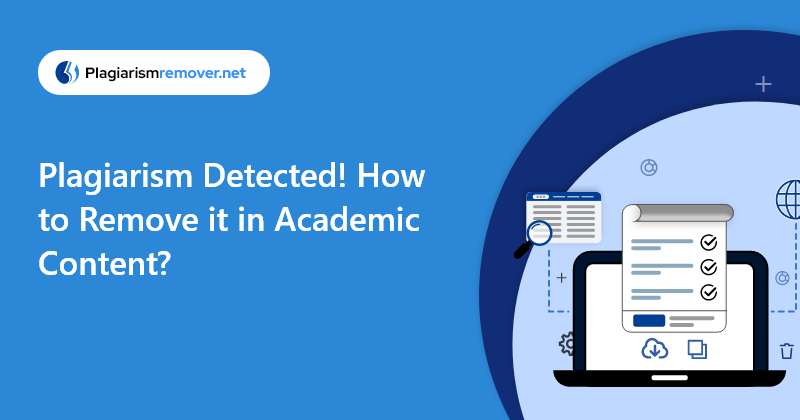There are almost 2 billion websites on the internet as of 2022.
From this gargantuan figure, ~200 million are active i.e., they have content added and updated on a regular basis.
But even the inactive ones are still present on the internet, and they show up in the indexing.
The point of all this? Imagine how much content that means.
How easy can it be to write something that is completely free from even a partial match from the whole pool of online content?
That’s right, folks. It isn’t. Honest writers who don’t have the slightest intention of copying anything can end up getting some plagiarism in their work.
And while it is important to eliminate plagiarism in any type of content, the need is more signified when you’re writing something academic.
Reliability is the be-all and end-all of academic content. If it’s not reliable, it’s not worth reading since there is no credibility in the stated facts or figures.
Plagiarism wrecks the reliability of academic content. That is why it is important to make sure that there are no matches in your content, should they be intentional or unintentional.
What is Plagiarism?
Plagiarism means to take a piece of content from a source, and use it elsewhere without giving any reference or citation to the original author.
There can be different ways in which plagiarism can be affected e.g., patchwork, direct copy, or improper paraphrasing.
In academic content, taking data and information from other studies and research paper is fine and normal.
However, whenever this is done, it is essential to mention the original authors and researchers by using in-text citations as well as proper references at the end.
If this step (citing and referencing) is omitted or done improperly, it can amount to plagiarism.
While educational institutions, in general, were always strict against plagiarism, it has been somewhat intensified in recent times.
During the days of Covid-19, the percentage of plagiarism in academic content submissions increased considerably.
As mentioned by the Oxford University Press, the percentage of content similarity rose from 35.1% to 49.6%.
This rise in the numbers can help us understand the reason behind the increased severity of actions taken against plagiarism in academic content.
…which in turn helps us realize the need of avoiding it all costs, and to always remove it where it creeps in unintentionally.
Why Plagiarism is Extremely Harmful in Academic Content?
As we mentioned before, plagiarism should be eliminated in academic content more than it should be in any type of writing.
In academic content, if the author copies something from another source without citing it, it will permanently damage their reputation.
The credibility in their writing will evaporate. They may even face more severe consequences like getting expelled or fired from their institution.
It is the integrity of an academic paper that makes it worthy of citing and mentioning elsewhere. Without that, the paper is pretty much worthless.
How to Remove Plagiarism in Academic Content
1. Cite...and do it properly!
If you copy-paste anything from a source without giving a citation, it will fall in the category of ‘Verbatim’ plagiarism.
If you copy-paste anything from a source with a citation, but an improper one, it will fall in the category of ‘Source-based Plagiarism’.
That basically tells us that citing the source is not enough. The citation should be correct and properly formatted.
You can use tools available on the internet for creating citations by entering URLs and DOI numbers.
But, when creating the citation, be sure of:
• Choosing the right format (Harvard, Chicago, APA, etc.)
• Including in-text citations as well as references (the latter are listed at the end and the former in between the text)
• Adding as many core elements as possible e.g., author name, date, page number, location, etc. Of all these, ‘author name’ and ‘date’ are the most important.
• If all of these are available, include them all. If any of them are missing, omit them and mention the ones that you can.
2. Paraphrase correctly
Paraphrasing and taking inspiration are two different things.
In the latter, you read and study some content and then come up with your own without copying the sentence structure or layout.
In the former, however, you only change the wording, and the layout of the text remains the same.
If you are paraphrasing something in your academic paper, be sure to include the citation of the source from where you took the original content.
Sure, it’s not exactly plagiarism, but some educational institutions can register it as such.
When paraphrasing, you can also use dedicated tool like rephrasing tool to make things quick and easy.
Using a smart algorithm, this tool can shuffle up the words in any given text, and give it a new look by adding synonyms in place of selected words.
But if you are only taking inspiration, then there is no need to cite anything since the content is technically (and truly) yours, and yours alone.
3. Use Plagiarism Checkers
And after you take the above steps, be sure to run your content through a plagiarism checker.
Doing this will help you remove any accidental and unintentional matches in your text.
There are a lot of checkers that you can use online for free. Although it is advisable to use paid software, the free apps can also get you along fine.
But even if you are using something free, pick it only if you have heard about its accuracy from some reliable source or from actual users.
Final Thoughts
If your academic content is found to have any plagiarism in it, it can lose its credibility and reliability.
While unintentional copying is still considered to be plagiarism, it does not have as adverse of an effect on the reputation of the author as deliberate copy-pasting and content snaffling.
In this post, we looked at some steps that you can follow to get rid of both of these types of plagiarism.

